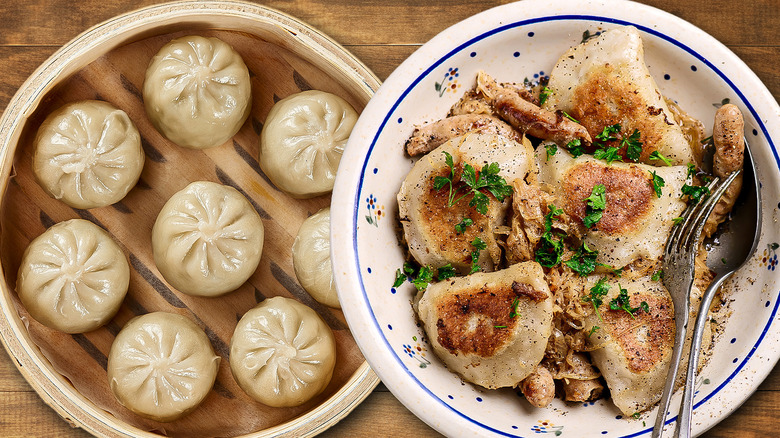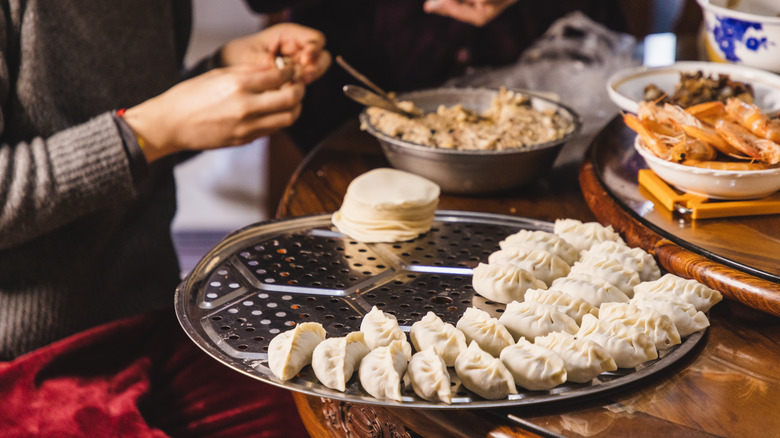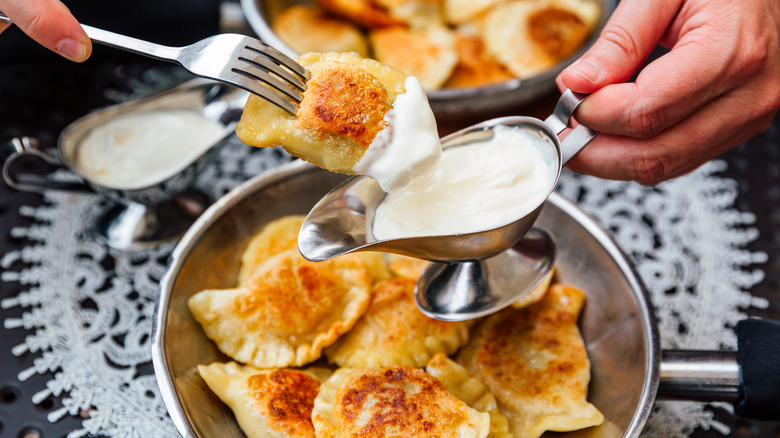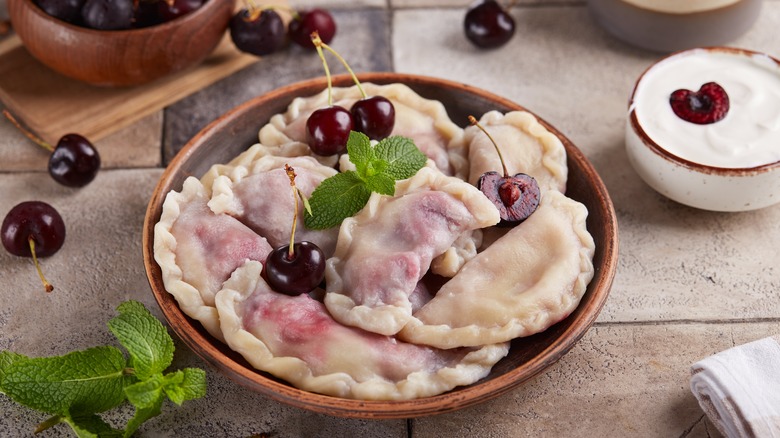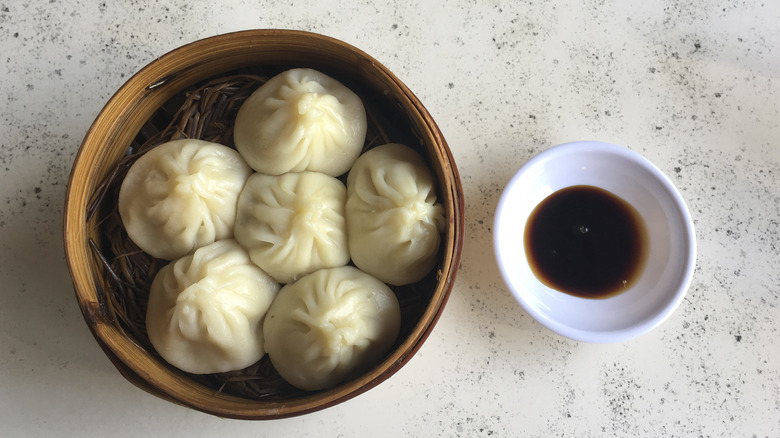Is There Really A Difference Between Dumplings And Pierogis?
When you hear the word dumpling, the image that springs to mind will largely depend on your background and cultural upbringing. For those of us who grew up around a large Asian population or a large Eastern European population, the word probably conjures an image of a collection of ingredients contained within a chewy wrapper. But depending on which of those two has a stronger association in your mind, you might call them "dumplings" or you might call them "pierogis." But are they actually the same thing?
From a culinary perspective, dumplings and pierogis are essentially the same thing: A disk of dough stuffed with a delicious filling and cooked to perfection. (In fact, "pierogis" is simply the Polish word for dumplings.) Add in that both dumplings and pierogis are considered comfort foods, and you might consider them to be the same dish. But these two foods have some key differences that set them apart, starting with their origins.
What are dumplings?
In reality, a dumpling refers to a wide range of foods that include a portion of cooked dough including everything from the fluffy, biscuit-like balls found in chicken and dumplings to the chewy, potato-based balls more commonly referred to as gnocchi. However, we're referring to a traditional Chinese dumpling in this case, which is a savory dish typically consisting of meat and vegetables wrapped in said dough. It's highly likely that this version of the dumpling was the first type ever made.
According to Chinese folklore, the dumpling came to be sometime between 206 BC and 220 AD as a result of a brutal winter where people needed a comforting meal that would help keep them warm. It's reasonable to assume that the original dumpling included some form of meat along with warming herbs and spices.
Today, dumplings hold a place of cultural significance in China, and although they're considered Northern Chinese cuisine, they're commonly enjoyed throughout the entire country (not to mention in many other countries). While people eat dumplings throughout the year and at any time of day, no Lunar New Year celebration would be complete without them. Dumplings "signify comfort, hope, and prosperity" and are often stuffed with different ingredients and different shapes to take on various meanings (such as wealth).
What are pierogis?
Strictly speaking, pierogis are the dumplings of Poland, although the dish is common throughout central, eastern, and southeastern Europe. The history of the pierogi is a hotly debated topic, but it's widely accepted that the dish made its way from China into eastern Europe.
Although pierogis first show up in the written in the 17th century, Polish legend has it that a saint served the dish to the poor as early as the 13th century. Somewhat contradictorily, pierogis became somewhat of a "special occasion" dish, with several variations recognizable by their various sizes and fillings. For example, the extra large kurniki made specifically for weddings, or the buckwheat-filled knysze, which often make an appearance at funerals.
Today, pierogis are enjoyed as an everyday dish throughout Poland and neighboring countries, with a wide variety of traditional fillings like potato and cheese. The dish has also become popular in countries around the globe, with some cultures putting their own twist on it. Notably in the United States, where you might find pierogis stuffed with sweet potato or jalapeño and cheddar.
Pierogis use a wider variety of ingredients
Arguably, dumplings and pierogis are close relatives, but they can differ quite significantly in the actual ingredients used and their final flavor profile. It starts with the dough. While dumpling dough is frequently made with just water, flour, and salt, pierogi dough generally includes some kind of fat in the form of butter or oil.
When it comes to fillings, dumplings and pierogis can skew in wildly opposite directions. For one, dumplings are nearly always savory. They can include an array of different ingredients, but it generally includes some combination of minced meat or seafood, shredded cabbage, mushrooms, ginger, garlic, and chives (sometimes along with soy sauce and sesame oil for flavor). For a traditional dumpling, you might go for a pork and cabbage dumpling recipe.
Pierogis tend to utilize a much wider variety of fillings. Traditional homemade pierogis may contain simply seasoned mashed potatoes — or potatoes and cheese — but that is just a drop in the bucket of what you can wrap up. We've seen all sorts of combos in terms of what pierogis are stuffed with, like mushroom and sauerkraut or salmon and cream cheese. There are even sweet pierogi recipes utilizing fillings like strawberries, vanilla, and ricotta for a dessert vibe.
Dumplings use a wider variety of cooking and serving methods
Dumplings and perogies also differ a bit in how they are formed, cooked, and served. For one, dumplings are often formed into various shapes — from crescents to pouches — depending on the type of dumpling, how it's being served, and what it might signify (for example, the moon shape represents good fortune). Pierogis are generally folded over simply into a half circle shape.
Dumplings also have more variation in how they are cooked. They may be boiled, steamed, or pan fried — or some mix of those methods. Pierogis are always boiled and may also be pan fried briefly before serving.
Finally, the two dishes are often served differently. Dumplings may be served on a platter, in a bamboo steamer basket, or in soup. And they almost always come with a dipping sauce or a selection of sauces to mix up your own — like black vinegar, soy sauce, and chili crisp. For pierogis, sauce is less of a requirement, although they are frequently served with sour cream and may be topped with a sauerkraut or sauteed cabbage.
